Updates on previous entries for Nov 27, 2013*
Brits label American states poorly orig. from Nov 27, 2013
* Q: Wha? A: These previously published entries have been updated with new information in the last 24 hours. You can find past updates here.
This site is made possible by member support. ❤️
Big thanks to Arcustech for hosting the site and offering amazing tech support.
When you buy through links on kottke.org, I may earn an affiliate commission. Thanks for supporting the site!
kottke.org. home of fine hypertext products since 1998.
Brits label American states poorly orig. from Nov 27, 2013
* Q: Wha? A: These previously published entries have been updated with new information in the last 24 hours. You can find past updates here.
Leo Tolstoy probably wasn’t thinking of an American Thanksgiving when he opened Anna Karenina with this line: “Happy families are all alike; every unhappy family is unhappy in its own way.” These days, all families — happy or not — are less alike than ever. In the NYT, Natalie Angier takes a look at the changing definition of family:
Families are more ethnically, racially, religiously and stylistically diverse than half a generation ago — than even half a year ago. In increasing numbers, blacks marry whites, atheists marry Baptists, men marry men and women women, Democrats marry Republicans and start talk shows.
And they’re all coming over to your house for Thanksgiving, which brings us to another quote — this one from Oscar Wilde: “After a good dinner one can forgive anybody, even one’s own relations.”

On Medium, an excerpt of Leander Kahney’s book on Jony Ive about how the iPhone came to be developed at Apple.
Excited by Kerr’s explanation of what a sophisticated touch interface could do, the team members started to brainstorm the kinds of hardware they might build with it.
The most obvious idea was a touchscreen Mac. Instead of a keyboard and mouse, users could tap on the screen of the computer to control it. One of the designers suggested a touchscreen controller that functioned as an alternate to a keyboard and mouse, a sort of virtual keyboard with soft keys.
As Satzger remembered, “We asked, How do we take a tablet, which has been around for a while, and do something more with it? Touch is one thing, but multitouch was new. You could swipe to turn a page, as opposed to finding a button on the screen that would allow you turn the page. Instead of trying to find a button to make operations, we could turn a page just like a newspaper.”
Jony in particular had always had a deep appreciation for the tactile nature of computing; he had put handles on several of his early machines specifically to encourage touching. But here was an opportunity to make the ultimate tactile device. No more keyboard, mouse, pen, or even a click wheel-the user would touch the actual interface with his or her fingers. What could be more intimate?
Buzzfeed asked some Brits to label states on a US map. They didn’t do so well:
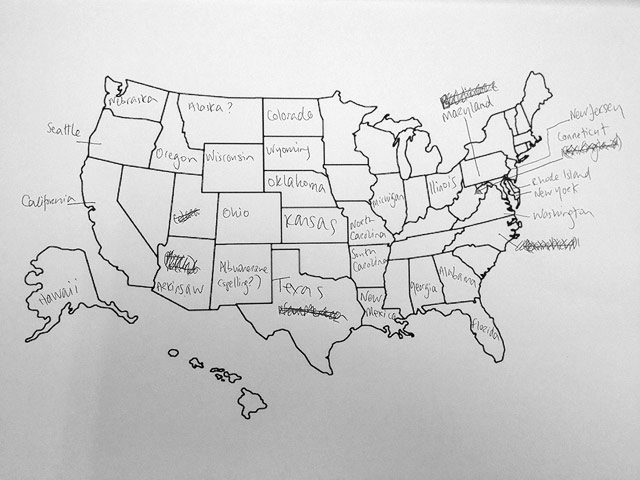
My favorite is “Further South Dakota”. In fairness, most US citizens would be hard pressed to name any of the counties of England, much less place them on a map.
Update: See how Americans fared on placing European countries. (Not well.)

Scheming boxes and this hungry helicopter are neck and neck for the greatest example of pareidolia (aka faces in things).
Burkhard Bilger got inside the secretive Google X lab and reports back on the search giant’s effort to build a self-driving car.
The Google car has now driven more than half a million miles without causing an accident-about twice as far as the average American driver goes before crashing. Of course, the computer has always had a human driver to take over in tight spots. Left to its own devices, Thrun says, it could go only about fifty thousand miles on freeways without a major mistake. Google calls this the dog-food stage: not quite fit for human consumption. “The risk is too high,” Thrun says. “You would never accept it.” The car has trouble in the rain, for instance, when its lasers bounce off shiny surfaces. (The first drops call forth a small icon of a cloud onscreen and a voice warning that auto-drive will soon disengage.) It can’t tell wet concrete from dry or fresh asphalt from firm. It can’t hear a traffic cop’s whistle or follow hand signals.
And yet, for each of its failings, the car has a corresponding strength. It never gets drowsy or distracted, never wonders who has the right-of-way. It knows every turn, tree, and streetlight ahead in precise, three-dimensional detail. Dolgov was riding through a wooded area one night when the car suddenly slowed to a crawl. “I was thinking, What the hell? It must be a bug,” he told me. “Then we noticed the deer walking along the shoulder.” The car, unlike its riders, could see in the dark. Within a year, Thrun added, it should be safe for a hundred thousand miles.
America’s legal system will make it difficult for self-driving cars to be accepted here…while not a legal kerfuffle yet, see Tesla’s current difficulties w/r/t fire risk in electric cars for a taste of what’s to come with self-driving cars. Europe is more likely…someplace like Holland or Denmark. They take their public and personal transportation seriously over there.
Gautam Narula on how you can improve your chess game rapidly.
The tl;dr of this training plan is, play a lot, analyze your games, and primarily study tactics. Your knowledge of openings, endgame, middlegame, etc. will come from analyzing your games and going over grandmaster games. Only study one of those specific topics if it is clear you are specifically losing because of that topic.
You’ve likely seen the various dialect maps of the US…the Coke/soda/pop maps. The Atlantic Video team did a wonderful thing with them…they called native speakers around the country and asked them to pronounce some of the words featured on these maps.
It’s one thing to read the difference between the pronounciations of “route”, it’s another thing entirely to hear them. I haven’t lived in the Midwest since 2000 and I have since transitioned from “pop” to “soda”, “waiting in line” to “waiting on line”, and am working on switching to “sneakers” from “tennis shoes” (or even “tennies”). But I was surprised to learn that I still pronounce “bag” differently than everyone else!

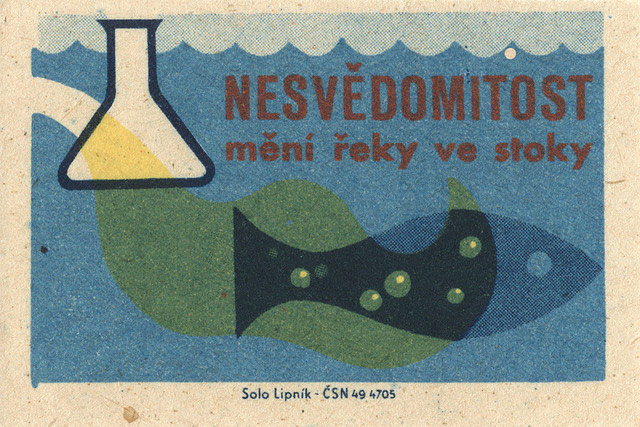
From Flickr, a collection of more than 1600 matchbox labels, most of them from Eastern Europe. (via @themexican)
The monarchs are late. Usually by the 1st of November, the forests of central Mexico are swarming with them. Last year, they came in record low numbers, only 60 million. This year? A week late and only 3 million. And this happening to insects across the spectrum.
A big part of it is the way the United States farms. As the price of corn has soared in recent years, driven by federal subsidies for biofuels, farmers have expanded their fields. That has meant plowing every scrap of earth that can grow a corn plant, including millions of acres of land once reserved in a federal program for conservation purposes.
Another major cause is farming with Roundup, a herbicide that kills virtually all plants except crops that are genetically modified to survive it.
As a result, millions of acres of native plants, especially milkweed, an important source of nectar for many species, and vital for monarch butterfly larvae, have been wiped out. One study showed that Iowa has lost almost 60 percent of its milkweed, and another found 90 percent was gone. “The agricultural landscape has been sterilized,” said Dr. Brower.
Steve James, the director of Hoop Dreams, is raising funds on Indiegogo for a documentary based on Roger Ebert’s memoir, Life Itself.
LIFE ITSELF, the first ever feature-length documentary on the life of Roger Ebert, covers the prolific critic’s life journey from his days at the University of Illinois, to his move to Chicago where he became the first film critic ever to win the Pulitzer Prize, then to television where he and Gene Siskel became iconic stars, and finally to what Roger referred to as “his third act”; how he overcame disabilities wrought by cancer to became a major voice on the internet and through social media.
Director Steve James (HOOP DREAMS) has conducted interviews with over two dozen people, including lifelong friends, professional colleagues, the first ever interview with Gene Siskel’s wife, and filmmakers Errol Morris, Werner Herzog, Ramin Bahrani, Gregory Nava, Ava DuVernay, and Martin Scorsese, who is one of the executive producers along with Steven Zaillian.
From All-You-Can-Eat Press in Brooklyn, the New York Ramen Map.
Attention noodle lovers: this is your lucky day! Our third publication-the New York Ramen Map-is here !! It features 33 of New York’s most interesting and delicious noodle shops, plus a special glossary and regional map of ramen in Japan.
Not sure I see my favorite place on there. Same folks also do a New York Doughnut Map and a New York Burger Map.
When Nirvana appeared on Top of the Pops in 1991, they were asked to only sing the lead vocal over an instrumental track. The result was perhaps the most unusual performance of Smells Like Teen Spirit ever, with the band barely playing their instruments in sync with the music and Cobain doing his best Ian Curtis/Morrisey impression.
From Wired’s Matthieu Aikins: The Surge.
In 1988 there were 350,000 cases of polio worldwide. Last year there were 223. But getting all the way to zero will mean spending billions of dollars, penetrating the most remote regions of the globe, and facing down Taliban militants to get to the last unprotected children on earth.
See also: Imagining a post-antibiotics future.
Pharrell has made a 24-hour music video of people dancing and lip-syncing that’s a cross between Christian Marclay’s The Clock and Girl Walk // All Day.
Girls. Trailer. Third season. HBO. January 12. Lena Dunham. Watch:
I am so excited for this show to return. I don’t think I can hide it. It’s like I’m about to lose control. Maybe I like that feeling?
The internet’s resident meteorologist Eric Holthaus (who incidentally has given up flying because of climate change) warns that a major storm could be on its way to the East Coast in time for Thanksgiving and Hanukkah (which overlap this year and then not again until the year 79811).
Technically, the storm is a nor’easter but is looking more like a tropical storm in the computer models:
At this point, the most likely scenario would be cold, wind-driven rain in the big coastal US cities, with up to a foot of snow stretching from inland New England as far south as the Carolinas. The cold would stick around after the storm exits, with high temperatures in the 20s and wind chills possibly in the single digits as far south as New Jersey on Black Friday.
According to this afternoon’s iteration of the Euro model (a meteorological model that famously predicted superstorm Sandy’s rare left hook into New Jersey six days out), at the storm’s peak, wind gusts on Cape Cod could approach hurricane force.
We’re still a ways out, so things might change, but travel safely next week, folks. (via @marcprecipice)
I have previously reported on Rutherford Chang and his large collection of first-pressings of The Beatles’ White Album.
Q: Are you a vinyl collector?
A: Yes, I collect White Albums.
Q: Do you collect anything other than that?
A: I own some vinyl and occasionally buy other albums, but nothing in multiples like the White Album.
Chang has taken 100 of those records, recorded the audio, and overlaid the resulting 100 tracks into one glorious track. Here’s Side 1 x 100 (Side 2 is available on vinyl only):
The albums, as it turns out, have also aged with some variety. Some played cleanly, others had scratches, noise from embedded dirt, or vinyl wear. And though the recordings are identical, variations in the pressings, and natural fluctuations in the speed of Mr. Chang’s analogue turntable, meant that the 100 recordings slowly moved out of sync, in the manner of an early Steve Reich piece: the opening of “Back in the U.S.S.R.” is entirely unified, but at the start of “Dear Prudence,” you hear the first line echoing several times, and by “While My Guitar Gently Weeps” the track is a nearly unrecognizeable roar.


Alexey Kljatov takes amazing photographs of snowflakes. Infinite beautiful variation. The large versions are worth checking out.
I linked to a stabilized version of the Zapruder film of JFK’s assassination a few years ago but Antony Davison has made a version that presents the whole film in panoramic HD, resulting in an amazingly clear representation of the event.
James Murphy (LCD Soundsystem) remixed David Bowie’s Love is Lost in the style of minimal music composer Steve Reich. Here’s the video for it by Barnaby Roper:
The video is NSFW, although most of the NS-ness is of the watching scrambled Cinemax on your uncle’s cable in 1985 variety (aka datamoshing).
This year’s allocation of Pappy Van Winkle’s cult bourbon was recently released. There’s never enough supply to meet demand, which means two things: lines rivaling iPhone release day queues and high resale prices.

On Craigslist in NYC, bottles of Pappy are for sale for hundreds and even thousands of dollars. One seller is offering a bottle of Pappy Van Winkle 23 Year for $1,250…that’s right around $80 for each 1.5 oz pour (without any markup).

Luckily, there are some close-but-not-quite alternatives. As this article on the bourbon family tree notes, the W.L. Weller 12 Year contains the same whiskey as Pappy 15 Year, but aged three fewer years. It can be readily found online for around $26 a bottle. To bump it perhaps a little closer to actual, Bourbonr has concocted what they call Poor Man’s Pappy:
Pick up a bottle of both W.L. Weller 12 (90 proof) and Old Weller Antique 107 (107 proof). They will cost around $20-$30 each. Start off with a 50:50 mixture of the two Bourbons. The easiest way to do this is with a digital scale. If you don’t have a scale just add a tablespoon from both Bourbons to your glass. With a 50:50 ratio you have a 98.5 proof delicious Bourbon.
Next, try a different ratio. Try mixing 60:40 Antique to 12. The Bourbon blend is now 100.2 proof and much closer in taste to the 107 proof Pappy 15.
Anyone else tried this? Thoughts?
A.J. Jacobs, who has done everything from attempting to become the world’s smartest person to living Biblically for a year, got ahold of Google Glass and used it the way that he was advised by Google not to. Jacobs used Glass to cheat at poker:
My cousin and I spend the day practicing our scheme. On his computer, he can see my cards. On my walnut-sized screen, I can see a teensy version of him holding up handwritten signs, like FOLD. Or RAISE TEN DOLLARS. Or CALL. I keep my cousin on mute for two reasons: First, I don’t want my fellow cardplayers to hear him. And second, he’s kind of a cocky bastard.
At 8:00 P.M. on a Thursday, my three unsuspecting friends come to my apartment. They know I’m testing Glass, but I tell them it’s only for e-mail. “Are you going to look up whether a straight beats a flush?” my friend Carl jokes. “Ha, ha,” I chuckle. “No, nothing like that.” (Though it’s true I barely know the rules.)
But he also uses it, Cyrano-style, to help a friend score with the ladies:
I’m married with three kids, and my wife has made it clear that Glass is not an aphrodisiac for her. So I figured I’d lend my device to a single twenty-six-year-old editor at Esquire. The plan: He’ll wear it to a downtown New York bar, and I’ll watch the live-stream video from home and tell him what to do. I’ll be his Cyrano. I’ll get a vicarious night on the town, all while eating my butternut-squash soup in the comfort of my home. I can’t wait.
I could imagine Glass Concierge becoming a future job title, basically a personal assistant who looks in on your Google Glass video feed to make helpful suggestions and advice, basically a rally co-driver for your life. (As long as your co-driver isn’t Vivek Ponnusamy.)
The Chess World Championship is currently underway in Chennai, India. Through nine games, challenger and world #1 Magnus Carlsen is leading reigning world champ and world #8 Viswanathan Anand by the score of 6-3. It seems as though Carlsen’s nettlesomeness is contributing to his good fortunes.
Second, Carlsen is demonstrating one of his most feared qualities, namely his “nettlesomeness,” to use a term coined for this purpose by Ken Regan. Using computer analysis, you can measure which players do the most to cause their opponents to make mistakes. Carlsen has the highest nettlesomeness score by this metric, because his creative moves pressure the other player and open up a lot of room for mistakes. In contrast, a player such as Kramnik plays a high percentage of very accurate moves, and of course he is very strong, but those moves are in some way calmer and they are less likely to induce mistakes in response.
Or perhaps Carlsen’s just inspired by the lovely chess set they’re using? Either way, he needs just one draw in the remaining three games to win the Championship. Or putting it another way, Anand has to win all three of the remaining games to retain the title.
Errol Morris and Tink Thompson share an obsession about the nature of photographic evidence. In a short film for the NY Times, Morris talks to Thompson about the photographic and filmic evidence of the JFK assassination, which Thompson has been investigating on and off since 1963.
Interesting that 1) there exists much more photographic evidence of the assassination than is commonly shown/known, and 2) Thompson very much has a theory of what the evidence shows but Morris doesn’t spill those particular beans:
Is there a lesson to be learned? Yes, to never give up trying to uncover the truth. Despite all the difficulties, what happened in Dallas happened in one way rather than another. It may have been hopelessly obscured, but it was not obliterated. Tink still believes in answers, and in this instance, an answer. He is completing a sequel to “Six Seconds” called “Last Second in Dallas.” Like its predecessor, this book is clearly reasoned and convincing. Of course, there will be people who will be unmoved by his or any other account.
See also Morris’ previous short film featuring Thompson & the assassination, The Umbrella Man.
[Mild spoilers] During the production of Gravity, Jonas Cuaron (co-writer of the screenplay and Alfonso Cuaron’s son) shot a short film that shows the other side of the conversation that Sandra Bullock’s character had while in the Soyuz capsule. In the film, an Inuit fisherman struggles to communicate with the distressed voice on the other end of his radio.
The short was filmed “guerrilla style” on location on a budget of about $100,000 — most of which went toward the 10-person crew’s travel costs — and Cuaron completed it in time to meld the dialogue into Gravity’s final sound mix. The result is a seamless conversation between Aningaaq and Ryan, stranded 200 miles above him, the twin stories of isolated human survival providing thematic cohesion. Still, Jonas says he was careful “to make it a piece that could stand on its own.” Should both get Oscar noms, an interesting dynamic would emerge: Two films potentially could win for representing different sides of one conversation, to say nothing of having come from father and son.
R. Kelly is some sort of random love song generating genius apparently. On a recent visit to the Rolling Stone offices, R. Ess asked R. Kelly to sing to them about dolphins, ice hockey, newspapers, and Italian heroes. The results R. Hilarious.
(via @leecrutchley who has a new book out.)
Your body clock alarm is just as accurate as the one on your phone: your body naturally takes note of what time you want to wake up and wakes you up.
There’s evidence you can will yourself to wake on time, too. Sleep scientists at Germany’s University of Lubeck asked 15 volunteers to sleep in their lab for three nights. One night, the group was told they’d be woken at 6 a.m., while on other nights the group was told they’d be woken at 9 a.m..
But the researchers lied-they woke the volunteers at 6 a.m anyway. And the results were startling. The days when sleepers were told they’d wake up early, their stress hormones increased at 4:30 a.m., as if they were anticipating an early morning. When the sleepers were told they’d wake up at 9 a.m., their stress hormones didn’t increase — and they woke up groggier. “Our bodies, in other words, note the time we hope to begin our day and gradually prepare us for consciousness,” writes Jeff Howe at Psychology Today.
(via digg)
Ben Blatt sat down with a bunch of Where’s Waldo? books and found a pattern to the striped beanpole’s hiding places.
It may not be immediately clear from looking at this map, but my hunch that there’s a better way to hunt was right. There isn’t one corner of the page where Waldo is always hiding; readers would have already noticed if his patterns were so obvious. What we do see, as highlighted in the map below, is that 53 percent of the time Waldo is hiding within one of two 1.5-inch tall bands, one starting three inches from the bottom of the page and another one starting seven inches from the bottom, stretching across the spread.
The Moken are a nomadic people who live on the coasts and islands of Thailand and Burma. They live off the bounty of the sea and have learned to control the size of the pupils in order to see better underwater.
Pupil constriction is triggered by incoming light levels — the less light (as at depth) the bigger the pupil — but the Moken have learned to override that implulse and keep their pupils small at low light levels, therefore making their eyesight sharper. (via the kid should see this)
The teams for the 2014 World Cup are almost all set (one qualifying game remains) and there are a lot of world-class players who won’t be playing in the tournament. ESPN FC has compiled a team of the best players who will miss out:

Bale, Lewandowski, and Ibrahimovic. That’s an amazing front line. If not for his hat trick yesterday, Cristiano Ronaldo, perhaps the best player in the world right now, would have made the roster in Ibrahimovic’s stead.
17-year-old Biggie Smalls freestyling orig. from Nov 19, 2013
* Q: Wha? A: These previously published entries have been updated with new information in the last 24 hours. You can find past updates here.
Per Betteridge’s law of headlines, the answer to this is “no”, but it’s still an interesting yarn.
Among the many enduring mysteries of this period is the fate of the world’s most famous painting. It seems that Leonardo da Vinci’s Mona Lisa was among the paintings found in the Altaussee salt mine in the Austrian alps, which was converted by the Nazis into their secret stolen-art warehouse.
The painting only “seems” to have been found there because contradictory information has come down through history, and the Mona Lisa is not mentioned in any wartime document, Nazi or allied, as having been in the mine. Whether it may have been at Altaussee was a question only raised when scholars examined the postwar Special Operations Executive report on the activities of Austrian double agents working for the allies to secure the mine. This report states that the team “saved such priceless objects as the Louvre’s Mona Lisa”. A second document, from an Austrian museum near Altaussee dated 12 December 1945, states that “the Mona Lisa from Paris” was among “80 wagons of art and cultural objects from across Europe” taken into the mine.
The Mona Lisa was actually stolen in 1911, in one of the cleverest art heists ever pulled.
This is great fun…the people on every channel of this TV are singing Like a Rolling Stone by Bob Dylan. Including Bob Dylan himself on VH1. (via @faketv)
From the Google Cultural Institute, an engaging account of how Lincoln wrote the Gettysburg Address, which was delivered 150 years ago today. There are actually five surviving copies of the text of the speech written in Lincoln’s hand; they’re all different and we don’t know for sure which one he read from. You can easily compare the different versions or see the handwritten versions. Here’s the Bliss Copy of the Gettysburg Address, which Lincoln wrote down in 1864, a few months after the speech:
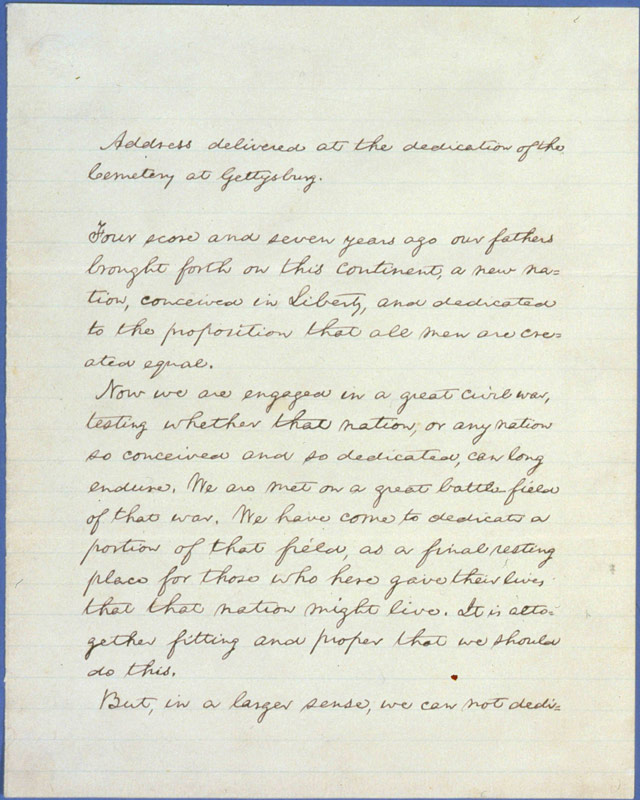
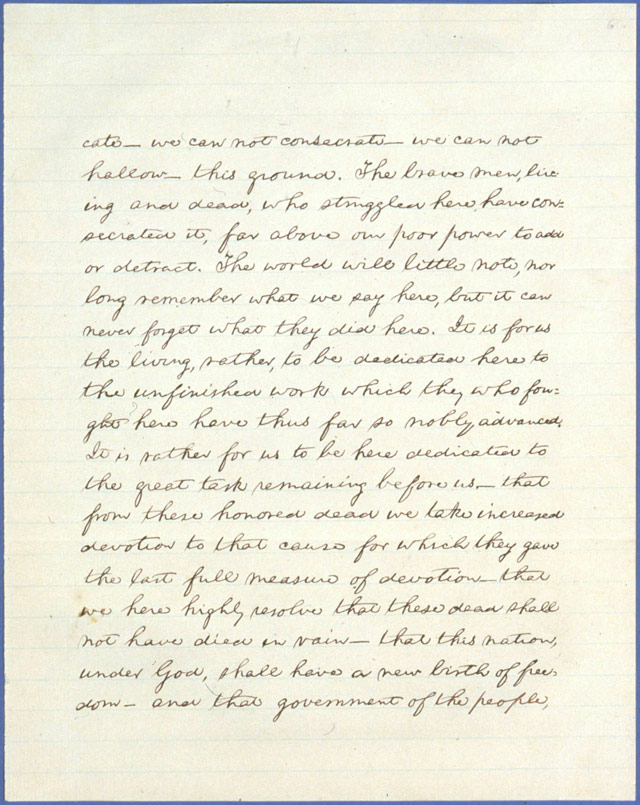
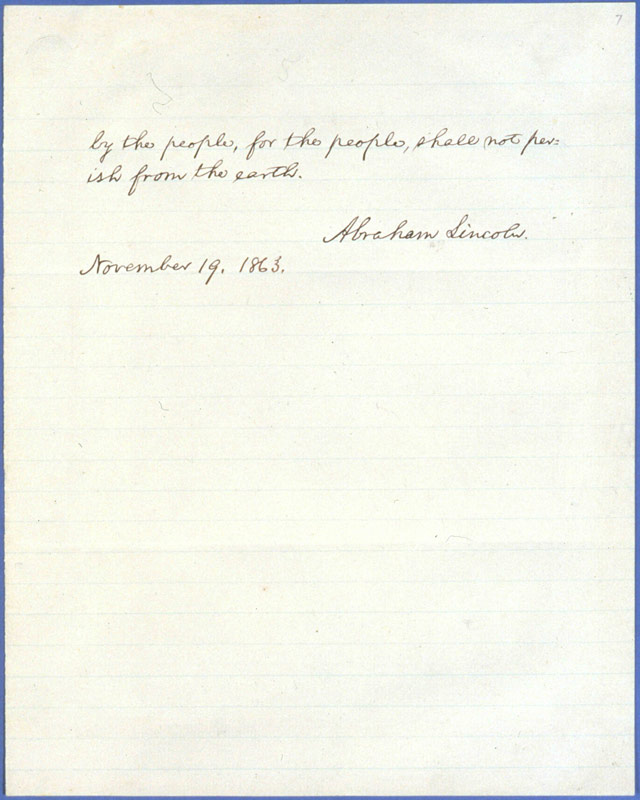
The Bliss Copy hangs in The White House and is the canonical version of the speech that you learned in school, hear in movies, read on the wall of the Lincoln Memorial, etc.
From Freestyle: The Art of the Rhyme, a short clip of a 17-year-old Christopher Wallace (aka Biggie Smalls, aka The Notorious B.I.G.) freestyle rapping on a street corner in Bed Stuy, Brooklyn in 1989.
It’s all there…the talent, the confidence, the skills. Compare with a 17-year-old LL Cool J rapping in a Maine gymnasium in 1985. (via ★interesting)
Update: Biggie was rapping on Bedford Ave between Quincy St and Lexington Ave in Bed-Stuy. Check it out on Google Maps. (thx, debbie)
![]()
I Pixel U is an iOS app that lets you selectively pixelate people and objects in photos, creating the effect of 8-bit characters in the real world. Many examples are available on Instagram.
See also Aled Lewis’ Video Games vs. Real Life series. (via prosthetic knowledge)
A short time before his death, Benoît B. Mandelbrot filmed an interview with Errol Morris. Morris charmingly starts off my asking Mandelbrot where “the fractal stuff” came from.
Note: as always, the “B.” in “Benoît B. Mandelbrot” stands for “Benoît B. Mandelbrot”. (via @sampotts)
Fascinating article about what it’s like to buy heroin on the west side of Chicago. The ritual of buying is just as exciting as the shooting up.
The fact is, and I don’t care who tries to dispute this, that a majority of the people who make the daily migration to the West Side to cop blows are as addicted to the ritual of copping dope as they are to the dope itself. It is an adrenaline rush no different than those achieved by people who jump out of airplanes. And dope fiends get to experience it every day.
(via @torrez)
From Wikipedia, a list of products and technologies that have been developed with the help of NASA, including memory foam, Dustbusters, and powdered lubricants.
For more than 50 years, the NASA Innovative Partnerships Program has connected NASA resources to private industry, referring to the commercial products as spin-offs. Well-known products that NASA claims as spin-offs include memory foam (originally named temper foam), freeze-dried food, firefighting equipment, emergency “space blankets”, Dustbusters, cochlear implants, and now Speedo’s LZR Racer swimsuits. NASA claims that there are over 1650 other spin-offs in the fields of computer technology, environment and agriculture, health and medicine, public safety, transportation, recreation, and industrial productivity.
NASA did not, however, invent Teflon or Velcro. (via @tangentialism)

It’s Friday. Let’s start with something awesome. The city of San Francisco has been transformed into Gotham City for a kid named Miles who has been battling leukemia since being diagnosed at the age of one. Miles’ wish was to be Batkid. Enter the Make-a-Wish foundation (with the help of thousands of people in San Francisco). Today, Miles is performing a series of superhero feats. The day started with a special front page of the San Francisco Chronicle. You can follow the adventures of Batkid at Buzzfeed and by following Make-a-Wish exec director Patricia Wilson on Twitter. And speaking of superhero feats, Miles’ leukemia is reportedly in remission.
It turns out that for many of the games on The Price is Right, a simple application of game theory is all you need to greatly increase your chances of winning. You don’t even need to know any of the prices.
In one instance, when Margie was the last contestant to bid, she guessed the retail price of an oven was $1,150. There had already been one bid for $1,200 and another for $1,050. She therefore could only win if the actual price was between $1,150 and $1,200. Since she was the last to bid, she could have guessed $1051, expanding her range by almost $100 (any price from $1051 to $1199 would have made her a winner), with no downside. What she really should have done, however, is bid $1,201. Game theory says that when you are last to bid, you should bid one dollar more than the highest bidder. You obviously won’t win every time, but in the last 1,500 Contestants’ Rows to have aired, had final bidders committed to this strategy, they would have won 54 percent of the time.
See also how a man named Terry Kniess solved The Price is Right.
The Giphoscope is a hand-cranked animated GIF player. At €299, this is the holiday gift for the animated GIF lover who has everything.

(via @Coudal)
The trailer for Alfonso Cuarón’s “Ikea”, a film about a man and a woman lost in the vast nothingness of Ikea.
(via ★interesting)
A chart of where many varieties of bourbon come from, along with five things you can learn from the chart.
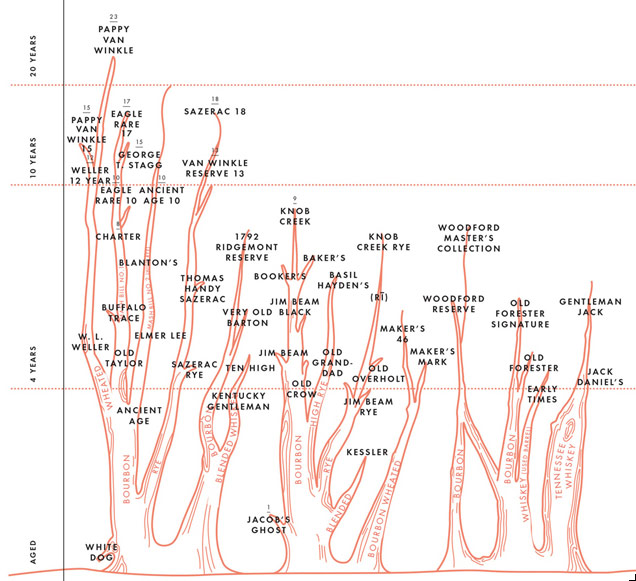
Pappy Van Winkle is frequently described by both educated and uneducated drinkers as the best bourbon on the market. It is certainly aged for longer than most premium bourbons, and has earned a near hysterical following of people scrambling to get one of the very few bottles that are released each year. Of the long-aged bourbons, it seems to be aged very gently year-to-year, and this recommends it enormously. But if you, like most people, can’t find Pappy, try W. L. Weller. There’s a 12 year old variety that retails for $23 around the corner. Pappy 15-year sells for $699-$1000 even though it’s the exact same liquid as the Pappy (same mash bill, same spirit, same barrels); the only difference is it’s aged 3 years less.
The chart is taken from the Kings County Distillery Guide to Urban Moonshining.
Written by the founders of Kings County Distillery, New York City’s first distillery since Prohibition, this spirited illustrated book explores America’s age-old love affair with whiskey. It begins with chapters on whiskey’s history and culture from 1640 to today, when the DIY trend and the classic cocktail craze have conspired to make it the next big thing. For those thirsty for practical information, the book next provides a detailed, easy-to-follow guide to safe home distilling, complete with a list of supplies, step-by-step instructions, and helpful pictures, anecdotes, and tips.
(via df)
Football as Football is a collection of American football team logos in the style of European football club badges. Here are badges for the Detroit Lions (in the Italian style) and New England Patriots (in the Spanish style).


Darren Aronofsky (Requiem for a Dream, The Wrestler, Black Swan) has made a movie called Noah, about Noah’s ark. It stars Russell Crowe, Jennifer Connelly, Emma Watson, and Anthony Hopkins. Here’s the trailer:
Spoiler: Noah survives and lives to the age of 950. More spoilers in Genesis Chapter 6. (via devour)
Kevin Kelley is the head football coach at Pulaski Academy in Little Rock, Arkansas. In games, he instructs his team to never punt, to never receive punts, and almost always onside kick.
The numbers Kelley cites are that eye-popping. And he isn’t cooking the books: Cal professor David Romer concluded that teams should not punt when facing fourth-and-4 or less; NFL stats analyst Brian Burke has detailed the need to rethink fourth-down decision-making; Football Outsiders has conflated punts with turnovers. You’ve even read about it on this site. Most fans and analysts who are willing to accept that change is a fundamental part of life have embraced the idea that automatically punting on fourth down doesn’t make sense.
Since Kelley took over, Pulaski is 124-22 and has won three state titles.
I love these color typologies by photographer Emily Blincoe. This gold candy one is particularly fetching:
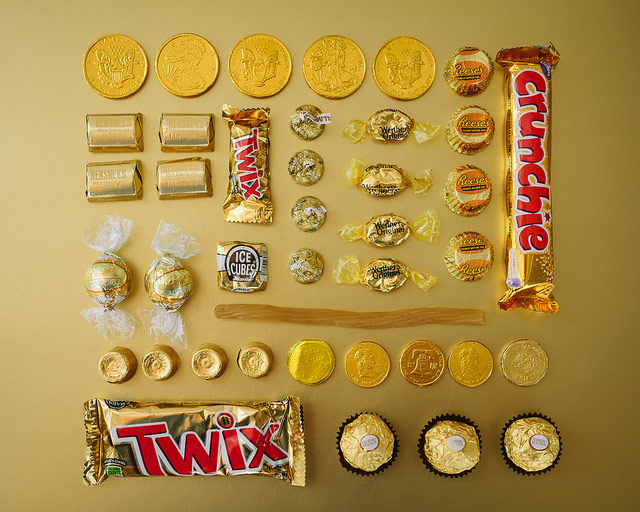
(via @mathowie)
Prolific and celebrated writer William T. Vollmann is a “devoted” cross-dresser.
Mr. Vollmann is 54, heterosexual and married with a daughter in high school. He began cross-dressing seriously about five years ago. Sometimes he transforms himself into a woman as part of a strange vision quest, aided by drugs or alcohol, to mind-meld with a female character in a book he’s writing. Other times it’s just because he likes the “smooth and slippery” feel of women’s lingerie.
He said his wife, who is an oncologist, is not thrilled with his outré experiments and keeps her distance. “Probably when the book comes out, it’ll be the first she’s heard of it,” he said. “I always try to keep my wife and child out of what I do. I don’t want to cause them any embarrassment.” He asked that his wife not be interviewed for this article.
Vollmann has collected self-portraits of himself as his female alter ego in The Book of Dolores. (via @DavidGrann)
Wes Anderson did a short film for Prada. The film contains race cars, Jason Schwartzman, Italy, and tweeness.
(via digg)
This video visualization of 15 different sorting algorithms is mesmerizing. (Don’t forget the sound.)
An explanation of the process. You can play with several different kinds of sorts here.
Felix Salmon shares perhaps the most reliable technique for turning money into happiness: buying and drinking expensive wine.
But here’s the trick: if you can’t buy happiness by spending more money on higher quality, then you can buy happiness by spending money taking advantage of all the reasons why people still engage in blind tastings, despite the fact that they are a very bad way to judge a wine’s quality. If you know what the wine you’re tasting is, if you know where it comes from, if you know who made it, if you’ve met the winemaker, and in general, if you know how expensive it is — then that knowledge deeply affects — nearly always to the upside — the way in which you taste and appreciate the wine in question.
Mark Wagner constructs intricate works of collage out of pieces of US $1 bills.
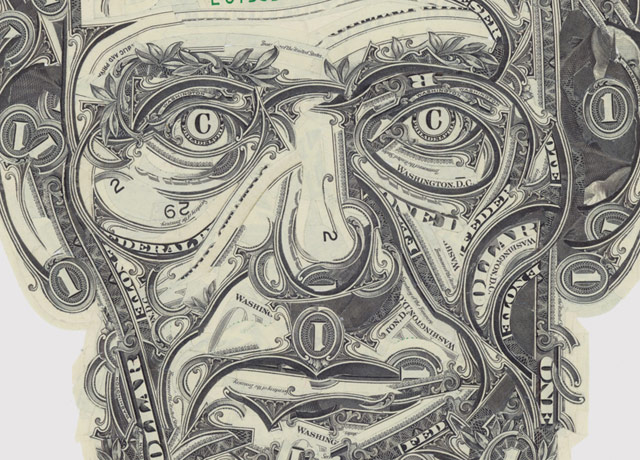
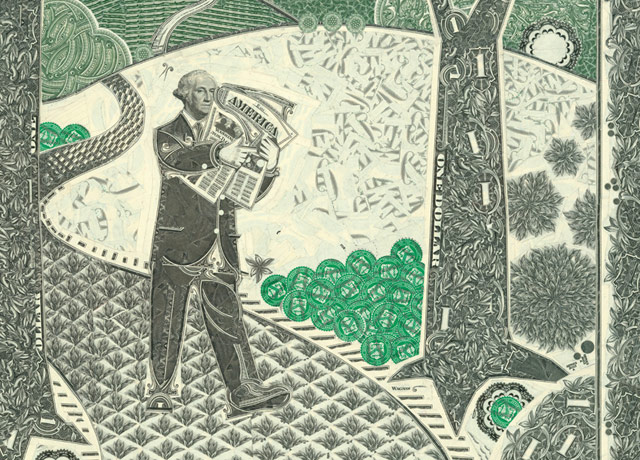

I love that last one. No Photoshop…he cuts and assembles the pieces by hand:
Hans Bethe was a giant in the field of nuclear physics. He rubbed shoulders with Einstein, Bohr, and Pauli, was head of the Theoretical Division of the US atomic bomb project, and was awarded a Nobel Prize. In 1999, at the age of 93, Bethe gave a series of three lectures to the residents of his retirement community near Cornell University, where he had taught since 1935. Video of the lectures is available on the Cornell website.
In the first lecture, Bethe covers the development of the “old quantum theory”, covering the work of Max Planck and Niels Bohr. In the second and third lectures, he relates how modern quantum mechanics was developed, with a healthy amount of personal recollection along the way:
Professor Bethe offers personal anecdotes about many of the famous names commonly associated with quantum physics, including Bohr, Heisenberg, Born, Pauli, de Broglie, Schrödinger, and Dirac.
Without a doubt, this is the most high-power presentation ever made at a retirement home. (via @stevenstrogatz)
One of my favorite books on technology, Tom Standage’s The Victorian Internet, was adapted into a TV documentary. It is now available on YouTube:
The Victorian Internet tells the colorful story of the telegraph’s creation and remarkable impact, and of the visionaries, oddballs, and eccentrics who pioneered it, from the eighteenth-century French scientist Jean-Antoine Nollet to Samuel F. B. Morse and Thomas Edison. The electric telegraph nullified distance and shrank the world quicker and further than ever before or since, and its story mirrors and predicts that of the Internet in numerous ways.
Writing in the Times, Frank Bruni notes the increasing tendency in the US to provide various levels of service for money.
Much has been made of commercial flights these days, with all those divisions between first class and coach. For various supplements or with various deals, you can get a few more inches of legroom or, shy of that, a prime aisle seat. You can get to board earlier or later, and thus hoard or miss out on the overhead bins. Will it be long before there’s a ranked queue for the bathroom? I’m not even sure I’m kidding.
It’s not that pecking orders or badges of affluence are anything new. Our homes, cars, clubs and clothes have long been advertisements of our economic clout, used and perceived that way.
But lately, the places and ways in which Americans are economically segregated and stratified have multiplied, with microclimates of exclusivity popping up everywhere. The plane mirrors the sports arena, the theater, the gym. Is it any wonder that class tensions simmer? In a country of rising income inequality and an economy that’s moved from manufacturing to services, one thing we definitely make in abundance is distinctions.
Reminds me of Tom Junod’s piece in Esquire about waiting in line as an expression of American democracy.
Apparently, an Englishman named Leonard Sim took his family to Disneyland a few years ago, and his vacation was ruined by waiting in line. He invented something called the Flash Pass, and then sold it to an English company called Lo-Q — as in “Low Queue” — which contracted it to Whitewater. So now, when you go to Whitewater and many other American amusement parks, you pay for parking ($15, at Whitewater), and then for admission ($37.50, for any human being over 48 inches tall), and finally for a locker ($16), and then, once you’re inside, you can pay an extra $30 for a “standard” Flash Pass or $40 for the “gold.” And then you can cut the lines.
It sounds like an innovative answer to the problem that everybody faces at an amusement park, and one perfectly in keeping with the approaches currently in place at airports and even on some crowded American highways — perfectly in keeping with the two-tiering of America. You can pay for one level of access, or you can pay for another. If you have the means, you can even pay for freedom. There’s only one problem: Cutting the line is cheating, and everyone knows it. Children know it most acutely, know it in their bones, and so when they’ve been waiting on a line for a half-hour and a family sporting yellow plastic Flash Passes on their wrists walks up and steps in front of them, they can’t help asking why that family has been permitted the privilege of perpetrating what looks like an obvious injustice. And then you have to explain not just that they paid for it but that you haven’t paid enough — that the $100 or so that you’ve ponied up was just enough to teach your children that they are second- or third-class citizens.
In 1898, an editor named Clement K. Shorter made a list of the 100 best novels (with an additional limit of one/author).
1. Don Quixote - 1604 - Miguel de Cervantes
2. The Holy War - 1682 - John Bunyan
3. Gil Blas - 1715 - Alain René le Sage
4. Robinson Crusoe - 1719 - Daniel Defoe
5. Gulliver’s Travels - 1726 - Jonathan Swift
6. Roderick Random - 1748 - Tobias Smollett
7. Clarissa - 1749 - Samuel Richardson
8. Tom Jones - 1749 - Henry Fielding
9. Candide - 1756 - Françoise de Voltaire
10. Rasselas - 1759 - Samuel Johnson
So much on there I’ve never even heard of. Compare this list with that of the best novels of the 20th century…how many of those novels and authors will readers be scratching their heads over in 2113? See also a contemporary list of the best books from before 1900. (via mr)
Google and NASA recently bought a D-Wave quantum computer. But according to a piece by Sophie Bushwick published on the Physics Buzz Blog, there isn’t scientific consensus on whether the computer is actually using quantum effects to calculate.
In theory, quantum computers can perform calculations far faster than their classical counterparts to solve incredibly complex problems. They do this by storing information in quantum bits, or qubits.
At any given moment, each of a classical computer’s bits can only be in an “on” or an “off” state. They exist inside conventional electronic circuits, which follow the 19th-century rules of classical physics. A qubit, on the other hand, can be created with an electron, or inside a superconducting loop. Obeying the counterintuitive logic of quantum mechanics, a qubit can act as if it’s “on” and “off” simultaneously. It can also become tightly linked to the state of its fellow qubits, a situation called entanglement. These are two of the unusual properties that enable quantum computers to test multiple solutions at the same time.
But in practice, a physical quantum computer is incredibly difficult to run. Entanglement is delicate, and very easily disrupted by outside influences. Add more qubits to increase the device’s calculating power, and it becomes more difficult to maintain entanglement.
(via fine structure)
Chris Pattle has constructed Simpsons characters completely out of CSS.
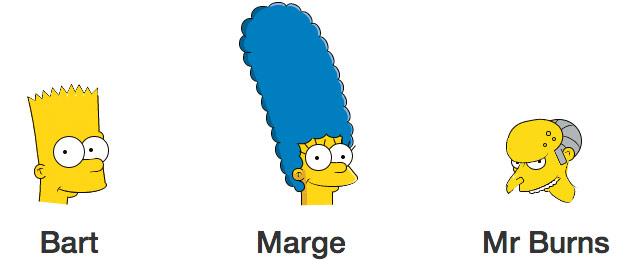
We’ve come a long way from #cccccc. And it looks like Pattle avoided the Simpson No-Nos.
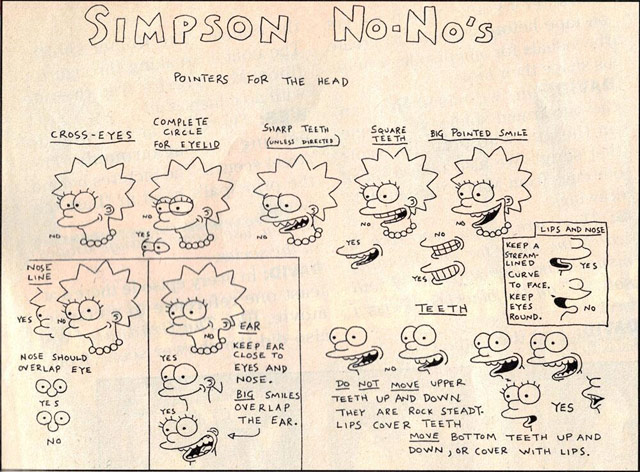
Esquire has Tom Junod writing profiles of the most famous men in Hollywood: Leonard DiCaprio, Matt Damon, and Brad Pitt. This month, Junod tackles George Clooney, who despite not having a big box office hit until Gravity, is right up there with Pitt, Cruise, and Hanks in pure wattage of stardom.
He has other houses. He has one, famously, on Lake Como, in Italy, and he has built another in Cabo. In this, he is not so much of a throwback-after all, Leonardo DiCaprio has a house in Cabo. Indeed, Clooney and DiCaprio once ran into each other in Cabo and struck up a conversation based on their common interest in basketball. They each have ongoing games, and their ongoing games have attained a celebrity of their own. Clooney suggested they might play someday. DiCaprio said sure, but felt compelled to add, “You know, we’re pretty serious.”
They played at a neighborhood court. “You know, I can play,” Clooney says in his living room. “I’m not great, by any means, but I played high school basketball, and I know I can play. I also know that you don’t talk shit unless you can play. And the thing about playing Leo is you have all these guys talking shit. We get there, and there’s this guy, Danny A I think his name is. Danny A is this club kid from New York. And he comes up to me and says, ‘We played once at Chelsea Piers. I kicked your ass.’ I said, ‘I’ve only played at Chelsea Piers once in my life and ran the table. So if we played, you didn’t kick anybody’s ass.’ And so then we’re watching them warm up, and they’re doing this weave around the court, and one of the guys I play with says, ‘You know we’re going to kill these guys, right?’ Because they can’t play at all. We’re all like fifty years old, and we beat them three straight: 11-0, 11-0, 11-0. And the discrepancy between their game and how they talked about their game made me think of how important it is to have someone in your life to tell you what’s what. I’m not sure if Leo has someone like that.”
I posted a video earlier today of a Super Cub airplane landing on the side of a mountain. Super Cubs are ideal for that undertaking because of their low stall speed and short take-off and landing distances. But I had no idea you could land and take off in one in the space of 20 feet.
Never seen a plane do that before…well, aside from tiny model planes. What an incredible power-to-weight ratio that plane must have. You can seriously land these things anywhere, almost like a helicopter. Wanna go fly fishing? Just set it down on the banks of a stream:
Or on a gravel bar in a river:
These planes are referred to as STOL (short takeoff and landing) aircraft; here’s some detail on how they work. (via @alper)
Update: Is this the shortest takeoff in history?
Six feet. Six. (via @mikebee)
When you read the title of this video, “Super Cub landing on windy mt. top”, you’re thinking, ok, there’s a runway on the side of this mountain and it’s gonna be a little dicey but not a big deal. But then the video starts and there’s just a steep snowy mountain and no runway and it’s uphill and you’re like, WHAT JUST HAPPENED?
I looked up info on the plane and if you’re going to land on the side of a mountain, the Super Cub is the plane for you. It can take off in as little as 200 feet, land in 300-400 feet, and has a stall speed of only 43 mph. The guy lands uphill and takes off downhill in this video and looks like he needed less than 100 feet in each case. (via ★mouser)
Just warning you, this piece by Ariel Levy will wreck you, put you back together, and wreck you again. Damn powerful beautiful writing.
My doctor told me that it was fine to fly up until the third trimester, so when I was five months pregnant I decided to take one last big trip. It would be at least a year, maybe two, before I’d be able to leave home for weeks on end and feel the elation of a new place revealing itself. (It’s like having a new lover-even the parts you aren’t crazy about have the crackling fascination of the unfamiliar.) Just before Thanksgiving, I went to Mongolia.
People were alarmed when I told them where I was going, but I was pleased with myself. I liked the idea of being the kind of woman who’d go to the Gobi Desert pregnant, just as, at twenty-two, I’d liked the idea of being the kind of girl who’d go to India by herself. And I liked the idea of telling my kid, “When you were inside me, we went to see the edge of the earth.” I wasn’t truly scared of anything but the Mongolian winter. The tourist season winds down in October, and by late November, when I got on the plane, the nights drop to twenty degrees below zero. But I was prepared: I’d bought snow pants big enough to fit around my convex gut and long underwear two sizes larger than I usually wear.
(via @DavidGrann)
In 1999, Sugata Mitra left a computer in a New Delhi slum and watched what the neighborhood kids would do with it. With no prior computer experience, they quickly figured out how to work it. In subsequent experiments, Mitra used computers and very little adult oversight (what we refer to as “education”) to teach children all sorts of different things.
Over the years, Mitra got more ambitious. For a study published in 2010, he loaded a computer with molecular biology materials and set it up in Kalikuppam, a village in southern India. He selected a small group of 10- to 14-year-olds and told them there was some interesting stuff on the computer, and might they take a look? Then he applied his new pedagogical method: He said no more and left.
Over the next 75 days, the children worked out how to use the computer and began to learn. When Mitra returned, he administered a written test on molecular biology. The kids answered about one in four questions correctly. After another 75 days, with the encouragement of a friendly local, they were getting every other question right. “If you put a computer in front of children and remove all other adult restrictions, they will self-organize around it,” Mitra says, “like bees around a flower.”
It’s tempting to conclude that the computer is the magical ingredient here: just add computers and children can learn anything. But if the story of Sergio Juárez Correa’s fifth-grade class is any indication, the secret is the kids organizing themselves to learn.
For Juárez Correa it was simultaneously thrilling and a bit scary. In Finland, teachers underwent years of training to learn how to orchestrate this new style of learning; he was winging it. He began experimenting with different ways of posing open-ended questions on subjects ranging from the volume of cubes to multiplying fractions. “The volume of a square-based prism is the area of the base times the height. The volume of a square-based pyramid is that formula divided by three,” he said one morning. “Why do you think that is?”
He walked around the room, saying little. It was fascinating to watch the kids approach the answer. They were working in teams and had models of various shapes to look at and play with. The team led by Usiel Lemus Aquino, a short boy with an ever-present hopeful expression, hit on the idea of drawing the different shapes-prisms and pyramids. By layering the drawings on top of each other, they began to divine the answer. Juárez Correa let the kids talk freely. It was a noisy, slightly chaotic environment-exactly the opposite of the sort of factory-friendly discipline that teachers were expected to impose. But within 20 minutes, they had come up with the answer.
“Three pyramids fit in one prism,” Usiel observed, speaking for the group. “So the volume of a pyramid must be the volume of a prism divided by three.”
Archer Lars Andersen can shoot 10 arrows in less than 5 seconds, without sacrificing power or accuracy. Andersen learned his technique by studying ancient archery practices…the key is holding the extra arrows in the hand and instinctive shooting.
Update: Anderson is back with a new video and new skills, like incoming shooting arrows with arrows of his own.
(via @psillin & @gavinpurcell)
I don’t wear cologne (or colon) or really care for the smell of perfume, but I love reading about perfume and scent. Roja Dove is an independent perfumer who creates bespoke scents for well-heeled clientele.
His custom-made leather Dunhill case holds small eyedropper bottles with the 238 tinctures, resinoids, absolutes and essential oils that comprise the “building blocks of every single fragrance that you can think of.” It also folds neatly into a piece of hand luggage should a client require him to pay a flying visit.
“Most of my formulas are quite short, normally between 20 and 50 ingredients,” he says. “It’s like painting; if you use too many colors, all you get is a dirty gray.”
An exhibition from Philip Worthington at MoMA last year turned people’s shadows into monsters. Joe Holmes turned his lens away from the shadows and instead captured the silhouettes of museums goers in their attempts to make shadows.


Hall of Famer Tony Dorsett is among a growing group of former NFL players who have been diagnosed with diseases caused by years of head trauma and other injuries.
The former Cowboys running back, now 59, said that when he took his Oct. 21 flight from Dallas to Los Angeles for testing, he repeatedly struggled to remember why he was aboard the plane and where he was going. Such episodes, he said, are commonplace when he travels.
Dorsett said he also gets lost when he drives his two youngest daughters, ages 15 and 10, to their soccer and volleyball games.
“I’ve got to take them to places that I’ve been going to for many, many, many years, and then I don’t know how to get there,” he said.
The 1976 Heisman Trophy winner and eighth all-time leading NFL rusher said he has trouble controlling his emotions and is prone to outbursts at his wife and daughters.
“It’s painful, man, for my daughters to say they’re scared of me.” After a long pause, he tearfully reiterated, “It’s painful.”
And I missed this last year, but former Bears QB Jim McMahon is suffering from early-stage dementia.
In an interview with Fox affiliate WFLD-TV, aired Wednesday, the 53-year-old McMahon says he knows where he’s going when in an airport. But when he meets people, “I’m asking two minutes later, ‘Who was that?’
“When my friends call and leave me a message … I’ll read it and delete it before I respond and then I forget who called and left me a message.”
McMahon says he is not worried about his mind withering away. He says he still reads a lot and is doing other things to keep his mind active. However, he said he doesn’t know whether he is getting worse.
These stories are just going to keep coming. Perhaps a true tipping point will come when one of the league’s past megastars is dianosed with CTE…if Brett Favre or Dan Marino or John Elway or Troy Aikman or Ray Lewis or any of the other former players that appear regularly on NFL game broadcasts announces he has CTE or dementia, maybe then the league will take real action? Or not? (via df)
Update: Former NFL player Kevin Turner died at 46 in March and his doctors say he had “advanced CTE” from repeated head trauma.
“This is not ALS; this is CTE,” McKee said. “The severity of Mr. Turner’s CTE was extraordinary and unprecedented for an athlete who died in his 40s.”
Turner died in March at age 46. He had spoken of his certainty that his declining physical state leading to his death was due to his football career. Doctors said they believed he had such advanced CTE because he endured decades of head traumas while playing football.
Hanukkah and Thanksgiving overlap this year…and then almost never again orig. from Jan 17, 2013
* Q: Wha? A: These previously published entries have been updated with new information in the last 24 hours. You can find past updates here.
Elizabeth Kolbert on yet another report which says that the future effects of anthropogenic climate change will be irreversible and catastrophic.
Promoting “preparedness” is doubtless a good idea. As the executive order notes, climate impacts — which include, but are not limited to, heat waves, heavier downpours, and an increase in the number and intensity of wildfires — are “already affecting communities, natural resources, ecosystems, economies, and public health across the Nation.” However, one of the dangers of this enterprise is that it tends to presuppose, in a Boy Scout-ish sort of way, that “preparedness” is possible.
As we merrily roll along, radically altering the planet, we are, as the leaked I.P.C.C. report makes clear, increasingly in danger of committing ourselves to outcomes that will simply overwhelm societies’ ability to adapt. Certainly they will overwhelm the abilities of frogs and trees and birds to adapt. Thus, any genuine “preparedness” strategy must include averting those eventualities for which preparation is impossible. This is not something that the President can do by executive order, but it’s something he ought to be pursuing with every other tool.
In linking to the piece, Philip Gourevitch notes:
This is simply the most important & urgent issue in our time & will be for as long as there is a foreseeable future
I wonder… what it’s gonna take for the world’s governments to lurch into action on this? Or will they ever? Years of iron-clad scientific consensus isn’t doing it. Sandy didn’t do it. Heat waves, wildfires, and floods seem to have little effect. The melting Arctic, ha! The risk to food and water supplies? Not really. For fun, here’s a Guardian piece from six years ago on 2007’s IPCC report, the same report Kolbert is referring to above.
Sea levels will rise over the century by around half a metre; snow will disappear from all but the highest mountains; deserts will spread; oceans become acidic, leading to the destruction of coral reefs and atolls; and deadly heatwaves will become more prevalent.
The impact will be catastrophic, forcing hundreds of millions of people to flee their devastated homelands, particularly in tropical, low-lying areas, while creating waves of immigrants whose movements will strain the economies of even the most affluent countries.
‘The really chilling thing about the IPCC report is that it is the work of several thousand climate experts who have widely differing views about how greenhouse gases will have their effect. Some think they will have a major impact, others a lesser role. Each paragraph of this report was therefore argued over and scrutinised intensely. Only points that were considered indisputable survived this process. This is a very conservative document — that’s what makes it so scary,’ said one senior UK climate expert.
It’s the same shit! It’s absurd.
Amazon introduced their Amazon Source program today, which enables indie booksellers to sell Kindles and receive a cut of future Kindle book sales made on those devices.
Retailers that are part of the program can use Amazon Source (http://source.amazon.com) to purchase Kindle devices and accessories for resale. Retailers can choose between two programs:
1) Bookseller Program: Earn 10% of the price of every Kindle book purchased by their customers from their Kindle devices for two years from device purchase. This is in addition to the discount the bookseller receives when purchasing the devices and accessories from Amazon.
2) General Retail Program: Receive a larger discount when purchasing the devices from Amazon, but do not receive revenue from their customers’ Kindle book purchases.
Amazon Source aside, I’ve often wondered if an independent bookstore could sell their usual selection of paper books but also sell Kindle books to those who wanted them. The bookstore would basically buy the books as gifts for the customer through Amazon and take the affiliate fee (which is 8.5% with sufficient monthly sales volume) as profit. (The fee on magazine subscriptions is 25%!) I love frequenting indie bookshops — the browsing experience of a good bookstore is still far superior to that on Amazon or a Kindle — but I don’t buy paper books anymore. So I usually leave bookstores with a list of 2-3 books I later buy on Amazon…it would be nice if the bookstore gets a cut of that action. If it worked well enough, the physical books in the store would be more like advertisements for the digital copies than salable items and you could change how you stock the store…less overall inventory or a more varied inventory with far less overhead.
Knowing next to nothing about the economics of bookstores, I don’t know how well that would actually work, but it would certainly be an interesting experiment. (via @tcarmody)
Earlier this year, Hogwarts School of Witchcraft and Wizardry was subjected to a review by the Board of Education and was found wanting in several areas.
Pupils at Hogwarts have access to a reasonably wide range of esoteric qualifications, suited to its key demographic. As an independent school, it does not have to follow the National Curriculum closely; however, it is disappointing to note that basic requirements such as English, Mathematics and Religious Education are all lacking or entirely missing from the school’s syllabus. This has had adverse effects on all students, many of whom have never even been taught basic KS1 or 2 literacy. A few students have attended state or independent primary schools, and these students typically perform very well in contrast to their peers.
The majority of students appear to be under-performing, with most pupils struggling in all their lessons, most of which appear to be set at too challenging a level. One particular class, which seemed to be based on A-Level chemistry, proved too difficult for even the most proficient students. Only one pupil managed to complete the lesson objectives, mainly thanks to his use of an annotated text book.
(via slate)
A video from Microsoft Research showcases a system that uses the Kinect motion sensing input device to translate between American Sign Language and other sign and spoken languages.
You can read more about the system at Microsoft Research.
From the Indiana Daily Student, the last days in the life of a Waffle House in Bloomington, Indiana.
Most of the students had stopped visiting years ago. The smoking ban forced out the puffers. Many of the regulars grew so old that they died or went to nursing homes.
Once Bud decided to close, it all slipped away even faster. Some of his staff had taken other jobs. The gumballs emptied out of the shiny red machine. No one bothered to mark the white board with the daily special.
They would close at precisely 3 p.m. Bud checked his watch, ignoring the broken wall clock, its hands frozen for more years than he could remember, stuck in time.
It suited the place.
Care of Google Maps, here’s the Waffle House before it got torn down. (via unlikely words)
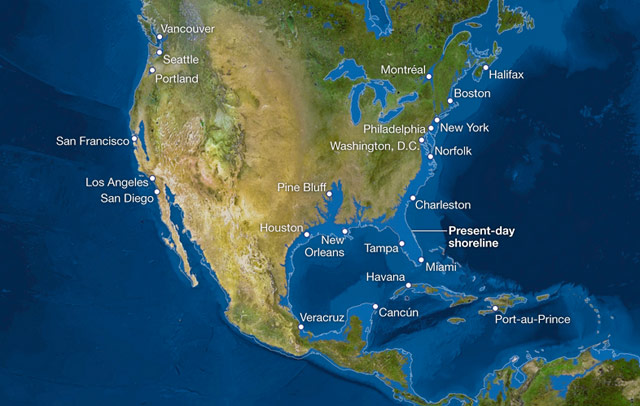
If all the glaciers and snow and ice in the world melted, the sea level would rise 216 feet and, as this National Geographic map of the world shows, things would look a little different.
There are more than five million cubic miles of ice on Earth, and some scientists say it would take more than 5,000 years to melt it all. If we continue adding carbon to the atmosphere, we’ll very likely create an ice-free planet, with an average temperature of perhaps 80 degrees Fahrenheit instead of the current 58.
See also Flood Maps.
There’s little doubt that meditation and mindfulness are extremely valuable. But these days, the labels are being attached to an increasing number of products and activities. And it’s no coincidence that many ancient practices are now getting a ton of buzz as our devices make it less and less likely that we’ll take the time to chill out, even for a few minutes a day. One of the ironies of the era is that you can now download apps that promise to help you meditate and be more mindful. It’s a familiar trend. Technology strips away something important. Then technology is created to fill the void. From the NYT: Mindfulness — getting its share of attention.
And here’s a Wired piece Noah Schactman wrote last summer: Meditation and mindfulness are the new rage in Silicon Valley. And it’s not just about inner peace — it’s about getting ahead. Om, Om, Ugh.
This is fun: a selection of pop songs separated into their component tracks (vocals, bass, drums, etc.). You can turn parts on and off as the songs play. Featured artists include The Beatles, Spice Girls, Radiohead, and Amy Winehouse.
The text/interface is in French…just click the dark grey link labelled “> Chanson” for the song listing. (via @ajsheets)
For the sufficiently skilled front-end loader driver, doing a front wheelie with a 20-ton machine is a piece of cake.
Got this from Modern Farmer’s selection of “Jaw-Dropping Russian Tractor Videos”; the other one I liked from the list is this guy who souped up his tractor with a car engine and then does donuts in his field.
Joe Posnanski thinks about how baseball would change if MLB moved to a 16-game schedule like the the NFL. I love stuff like this.
4. Baseball would become dramatically more violent.
I’m not 100% certain of this, of course. But I am probably 75% certain. Right now, we don’t tend to think of baseball as a contact sport. There IS contact — plays at the plate, double-play meetings at second base, the occasional hit-by pitch and ensuing bench-clear — but it’s mostly tangential to the game. Football, meanwhile, is violent at its core. Or anyway, that’s what we think now.
Except — baseball was extremely violent in its early days. And I think that if the game was played just once a week, if you faced each team only once or twice a season, if every game was critical, there would be a lot more violence in baseball. Collisions at the plate would be intensified. Nobody would concede the double play without really taking out the fielder. Pitchers would be much more likely to send message pitches. And I think you would probably find violence where there is none right now.
(via mr)
New Zealand journalist Duncan Greive caught onto Lorde early and has written the self-styled “definitive inside account of Ella Yelich-O’Conner’s rise to the top”.
For advertising, Maclachlan calls in Alistair Cain, Universal New Zealand’s head of marketing, and plays an early cut of the television commercial on his computer. Ella wants to keep the date rendered in Roman numerals. It looks crazy (XXVII.IX.MMXIII). She won’t be moved. After an hour, they’re done.
Afterwards, Cain says that in 20 years in the industry he’s never come across an artist so engaged with the minutiae of their presentation. He points up at a giant poster of Lana Del Rey. “With her, we could do whatever we liked,” he says.
Ella is frequently compared to Del Rey, though it infuriates her. Both are white women making pop music soaked in the rhythm and attitude of hip-hop. But Del Rey has a much more conventional narrative — she had an image makeover prior to her breakout Born To Die album, and co-writes her songs with some of the biggest producers and writers in the industry.
Ella’s songs, meanwhile, are very much her vision, and hers alone.
For the New Yorker, B.J. Novak writes about the guy who invented the calendar.
February 1st-Another small fuckup: I put an extra “r” in all the copies of the calendar I handed out, even though I already told everyone the next month coming was called Febuary. But Alice came up with the best solution! She said, “Just tell everyone it’s spelled ‘February’ but pronounced ‘Feb-u-ary.’ That way, they’ll feel stupid!” Alice is the best.
February 14th-Alice stuff weird. Tonight we were having a nice dinner at the same place we always go, but she was unusually quiet. Finally, I asked if anything was wrong, and she said, “Do you know what day it is today?” I said, “Yes, of course I do, I invented the calendar. It’s February 14th. Why?” She smiled a really tight smile, said, “Yes. Yes, it is,” and then walked out. What’s that about?
February 15th-So cold.
February 28th-I hate this month. I can’t take one more day of it. This month will just have to be shorter than the rest, and if people don’t like it they can go fuck themselves.
A mouse finds a cracker about his own size and thinks, “this is great, I’ll be able to eat for a week!” But he can’t quite get the cracker up and over the short ledge that leads back to his hole. But he doesn’t give up that easily:
(via ★interesting)
It’s not up on their web site or YouTube yet, but I’m pretty sure this is a prototype of a new dancing robot built by Boston Dynamics, makers of the Big Dog, Cheetah, and Petman robots.
Looks similar to Atlas or Petman, but way more advanced…how did they pack all of the circuitry and power supplies into such a small yet realistic-looking housing? (via devour)
Some Hollywood people are making a Lego movie called The Lego Movie. Batman’s in it and the plot is from The Matrix. I can’t decide if it looks horrible or amazing.
An ordinary guy named Emmet (Chris Pratt) is mistaken as being the Master Builder, the one who can save the Lego universe. With the aid of an old mystic named Vitruvius (Morgan Freeman), a tough young lady named Wyldstyle (Elizabeth Banks), and Batman (Will Arnett), Emmet will fight to defeat the evil tyrant Lord Business (Will Ferrell) who is bent on destroying the Lego universe by gluing it together.
The Wikipedia page notes The Lego Movie Video Game will be released in conjunction with the movie. Which, if you’re following along, is a video game based on a movie based on stacking toys & figures containing characters based on other movies that are based on comic books. I can’t wait for The Lego Movie Videogame Comic Book Movie that comes out in 2019.
Roland Deschane took a few paintings by cheeseball artist Thomas Kinkade and incorporated Star Wars characters into them.

(via @Coudal)
From Seth Stevenson, an appreciation of leaving social occasions without saying goodbye.
These sorts of goodbyes inevitably devolve into awkward small talk that lasts too long and then peters out. We vow vaguely to meet again, then linger for a moment, thinking of something else we might say before the whole exchange fizzles and we shuffle apart. Repeat this several times, at a social outing delightfully filled with your acquaintances, and it starts to sap a not inconsiderable portion of that delight.
Stay Connected